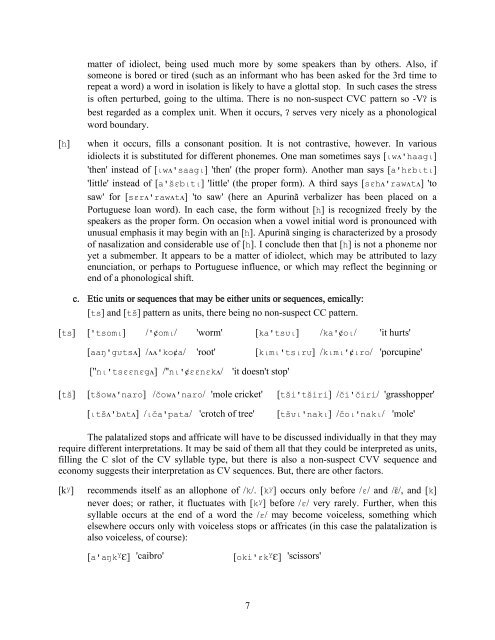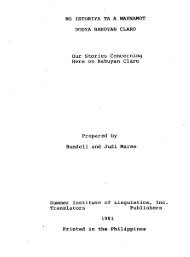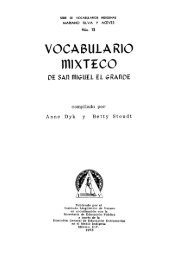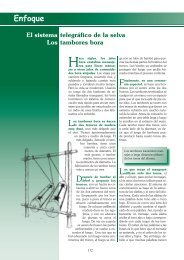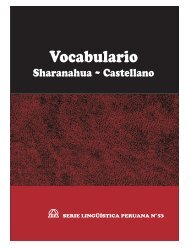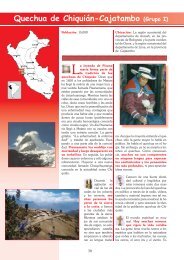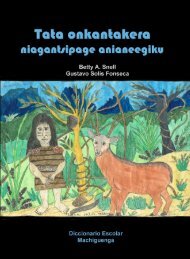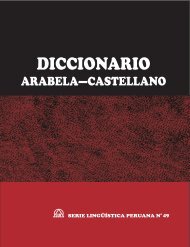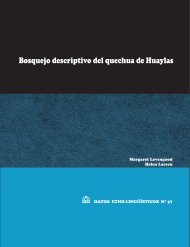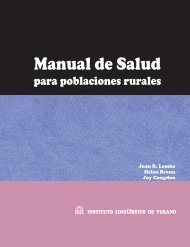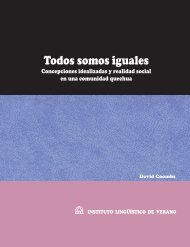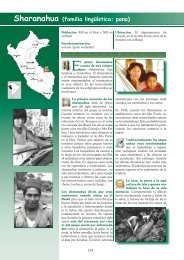A Phonemic Analysis of the Apurinã Language
A Phonemic Analysis of the Apurinã Language
A Phonemic Analysis of the Apurinã Language
Create successful ePaper yourself
Turn your PDF publications into a flip-book with our unique Google optimized e-Paper software.
matter <strong>of</strong> idiolect, being used much more by some speakers than by o<strong>the</strong>rs. Also, ifsomeone is bored or tired (such as an informant who has been asked for <strong>the</strong> 3rd time torepeat a word) a word in isolation is likely to have a glottal stop. In such cases <strong>the</strong> stressis <strong>of</strong>ten perturbed, going to <strong>the</strong> ultima. There is no non-suspect CVC pattern so -Vʔ isbest regarded as a complex unit. When it occurs, ʔ serves very nicely as a phonologicalword boundary.[h]when it occurs, fills a consonant position. It is not contrastive, however. In variousidiolects it is substituted for different phonemes. One man sometimes says [ιwʌ'haagι]'<strong>the</strong>n' instead <strong>of</strong> [ιwʌ'saagι] '<strong>the</strong>n' (<strong>the</strong> proper form). Ano<strong>the</strong>r man says [a'hεbιtι]'little' instead <strong>of</strong> [a'šεbιtι] 'little' (<strong>the</strong> proper form). A third says [sεhʌ'rawʌtʌ] 'tosaw' for [sεrʌ'rawʌtʌ] 'to saw' (here an Apurinã verbalizer has been placed on aPortuguese loan word). In each case, <strong>the</strong> form without [h] is recognized freely by <strong>the</strong>speakers as <strong>the</strong> proper form. On occasion when a vowel initial word is pronounced withunusual emphasis it may begin with an [h]. Apurinã singing is characterized by a prosody<strong>of</strong> nasalization and considerable use <strong>of</strong> [h]. I conclude <strong>the</strong>n that [h] is not a phoneme noryet a submember. It appears to be a matter <strong>of</strong> idiolect, which may be attributed to lazyenunciation, or perhaps to Portuguese influence, or which may reflect <strong>the</strong> beginning orend <strong>of</strong> a phonological shift.c. Etic units or sequences that may be ei<strong>the</strong>r units or sequences, emically:[ts] and [tš] pattern as units, <strong>the</strong>re being no non-suspect CC pattern.[ts] ['tsomι] /'ȼomι/ 'worm' [ka'tsυι] /ka'ȼoι/ 'it hurts'[aaŋ'gυtsʌ] /ʌʌ'koȼa/ 'root' [kιmι'tsιrυ] /kιmι'ȼιro/ 'porcupine'[''nι'tsεεnεgʌ] /''nι'ȼεεnεkʌ/ 'it doesn't stop'[tš] [tšowʌ'naro] /čowʌ'naro/ 'mole cricket' [tši'tširi] /či'čiri/ 'grasshopper'[ιtšʌ'bʌtʌ] /ιča'pata/ 'crotch <strong>of</strong> tree'[tšυι'nakι] /čoι'nakι/ 'mole'The palatalized stops and affricate will have to be discussed individually in that <strong>the</strong>y mayrequire different interpretations. It may be said <strong>of</strong> <strong>the</strong>m all that <strong>the</strong>y could be interpreted as units,filling <strong>the</strong> C slot <strong>of</strong> <strong>the</strong> CV syllable type, but <strong>the</strong>re is also a non-suspect CVV sequence andeconomy suggests <strong>the</strong>ir interpretation as CV sequences. But, <strong>the</strong>re are o<strong>the</strong>r factors.[k y ] recommends itself as an allophone <strong>of</strong> /k/. [k y ] occurs only before /ε/ and /ɛ̃/, and [k]never does; or ra<strong>the</strong>r, it fluctuates with [k y ] before /ε/ very rarely. Fur<strong>the</strong>r, when thissyllable occurs at <strong>the</strong> end <strong>of</strong> a word <strong>the</strong> /ε/ may become voiceless, something whichelsewhere occurs only with voiceless stops or affricates (in this case <strong>the</strong> palatalization isalso voiceless, <strong>of</strong> course):[a'aŋk Y Ɛ] 'caibro'[oki'εk Y Ɛ] 'scissors'7


